Effects of a 30 K Military Loaded Carriage on the Neuromuscular System in Spanish Army Marines
Abstract
1. Introduction
2. Materials and Methods
2.1. Study Design
2.2. Participants
2.3. Procedures
2.4. Statistical Analyses
3. Results
4. Discussion
5. Conclusions
Author Contributions
Funding
Institutional Review Board Statement
Informed Consent Statement
Data Availability Statement
Acknowledgments
Conflicts of Interest
Appendix A
Appendix A.1
| PRE | POST | 24 H POST | 48 H POST | ES 1 | ES 2 | ES 3 | |
|---|---|---|---|---|---|---|---|
| ROF [points] | 1.96 ± 0.56 | 7.57 ± 0.66 ‡ | 4.96 ± 1.19 ‡Ψ | 3.43 ± 1.12 ‡ΨͲ | −6.29 | −2.12 | −1.10 |
| BM [kg] | 80.00 ± 7.79 | 77.26 ± 7.88 ‡ | 78.40 ± 7.81 ‡¥ | 78.55 ± 8.03 ‡Ψ | 1.88 | 2.50 | 2.06 |
| PUmax [reps] | 17.70 ± 3.23 | 13.91 ± 3.48 ‡ | 15.65 ± 2.72 ‡Ψ | 16.65 ± 3.19 ‡ΨͲ | 2.01 | 1.54 | 1.48 |
| DHGS [kg] | 49.71 ± 6.86 | 51.32 ± 7.38 | 51.21 ± 7.33 | 50.30 ± 6.94 | −0.43 | −0.35 | −0.14 |
| NDHGS [kg] | 47.15 ± 7.05 | 48.65 ± 6.72 | 47.71 ± 6.31 | 47.90 ± 6.34 | −0.22 | −0.12 | −0.12 |
| IMTP [N] | 2612.26 ± 290.99 | 2636.70 ± 292.59 | 2463.43 ± 301.28 †§ | 2486.43 ± 247.72 ‡§ | −0.09 | 0.61 | 0.79 |
| VJ CMJ [cm] | 32.16 ± 5.96 | 27.78 ± 6.23 ‡ | 28.47 ± 4.81 ‡ | 27.67 ± 4.50 ‡ | 1.16 | 1.27 | 1.20 |
| PP CMJ [W] | 3741.83 ± 573.54 | 3703.17 ± 499.01 | 3420.83 ± 417.86 †¥ | 3401.26 ± 462.75 ‡¥ | 0.08 | 0.65 | 0.76 |
| RFDEcc CMJ [N/s] | 3469.65 ± 2562.48 | 3318.61 ± 1971.24 | 3695.43 ± 1978.30 | 3592.96 ± 2044.50 | 0.11 | −0.16 | −0.08 |
| RFDCon CMJ [N/s] | 1995.13 ± 1756.84 | 2123.52 ± 1509.48 | 1077.99 ± 935.26 †¥ | 1754.91 ± 1421.64 Ᵹ | −0.05 | 0.59 | 0.14 |
| PEcc CMJ [N] | 1605.13 ± 362.37 | 1494.83 ± 370.90 * | 1598.30 ± 315.69 Ψ | 1611.22 ± 315.12 ¥ | 0.51 | 0.03 | −0.03 |
| PCon CMJ [N] | 1775.61 ± 250.79 | 1805.57 ± 197.93 | 1735.61 ± 217.53 | 1781.48 ± 231.25 | −0.15 | 0.27 | −0.05 |
Appendix A.2
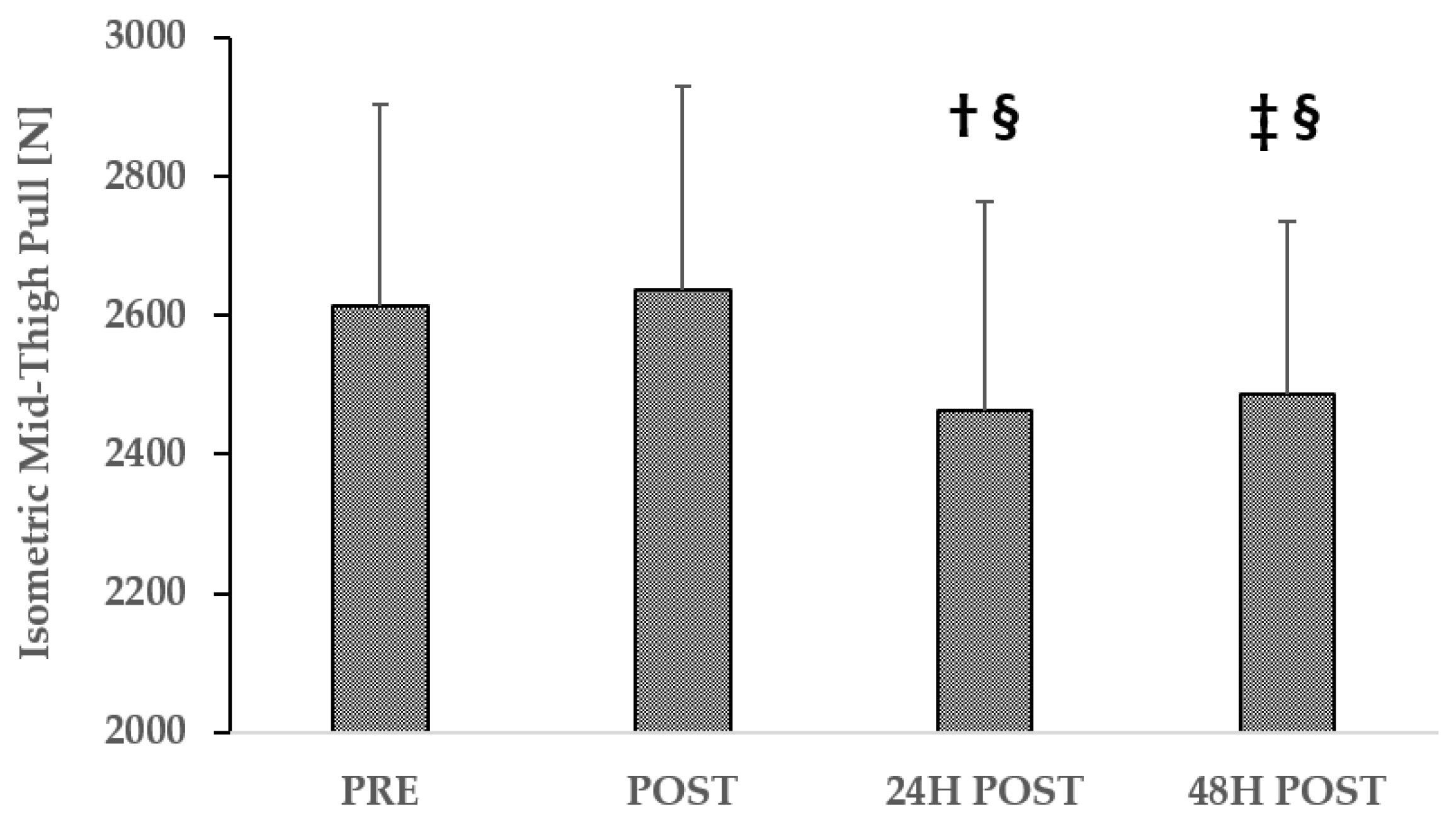
Appendix A.3
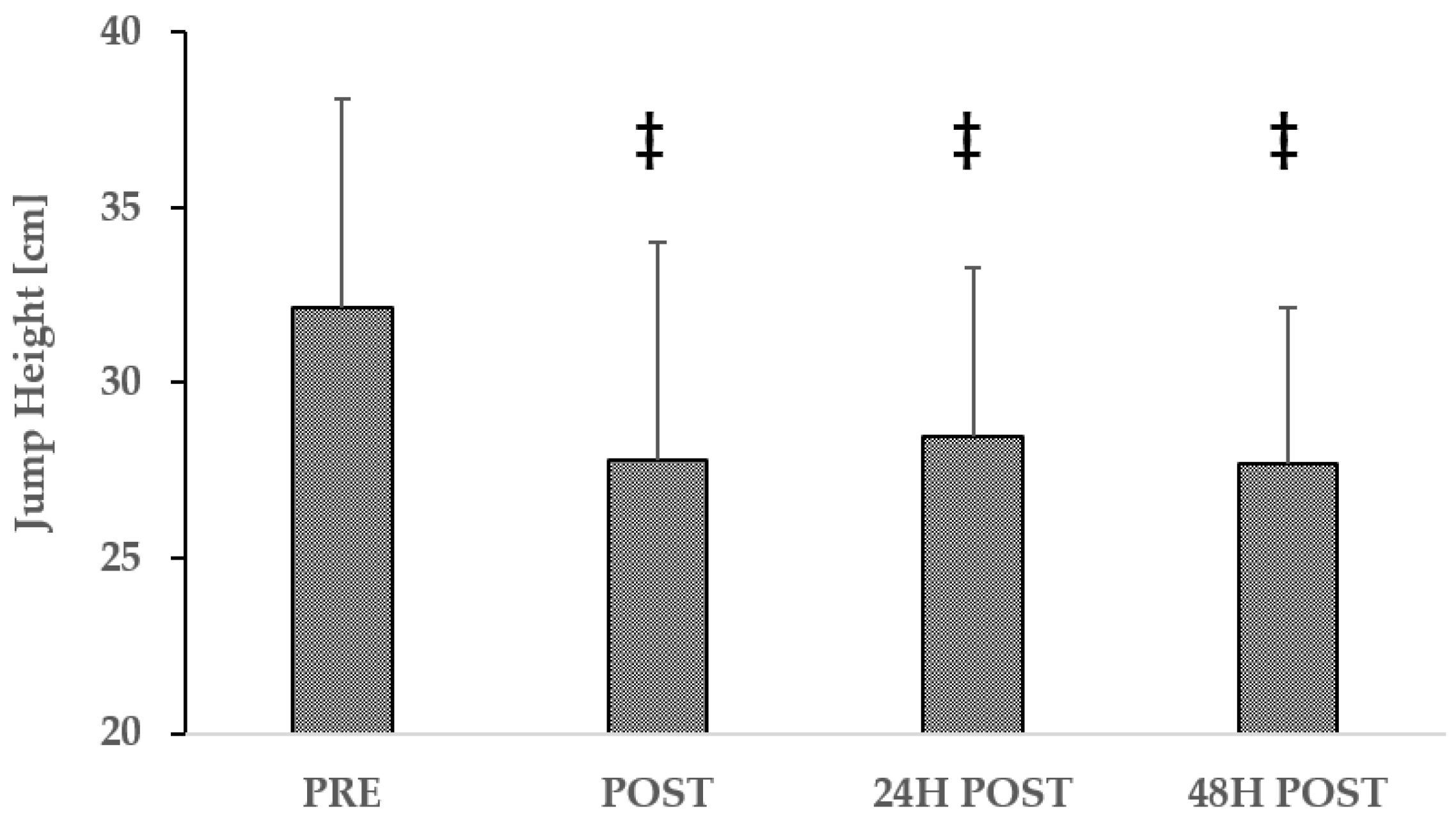
Appendix A.4
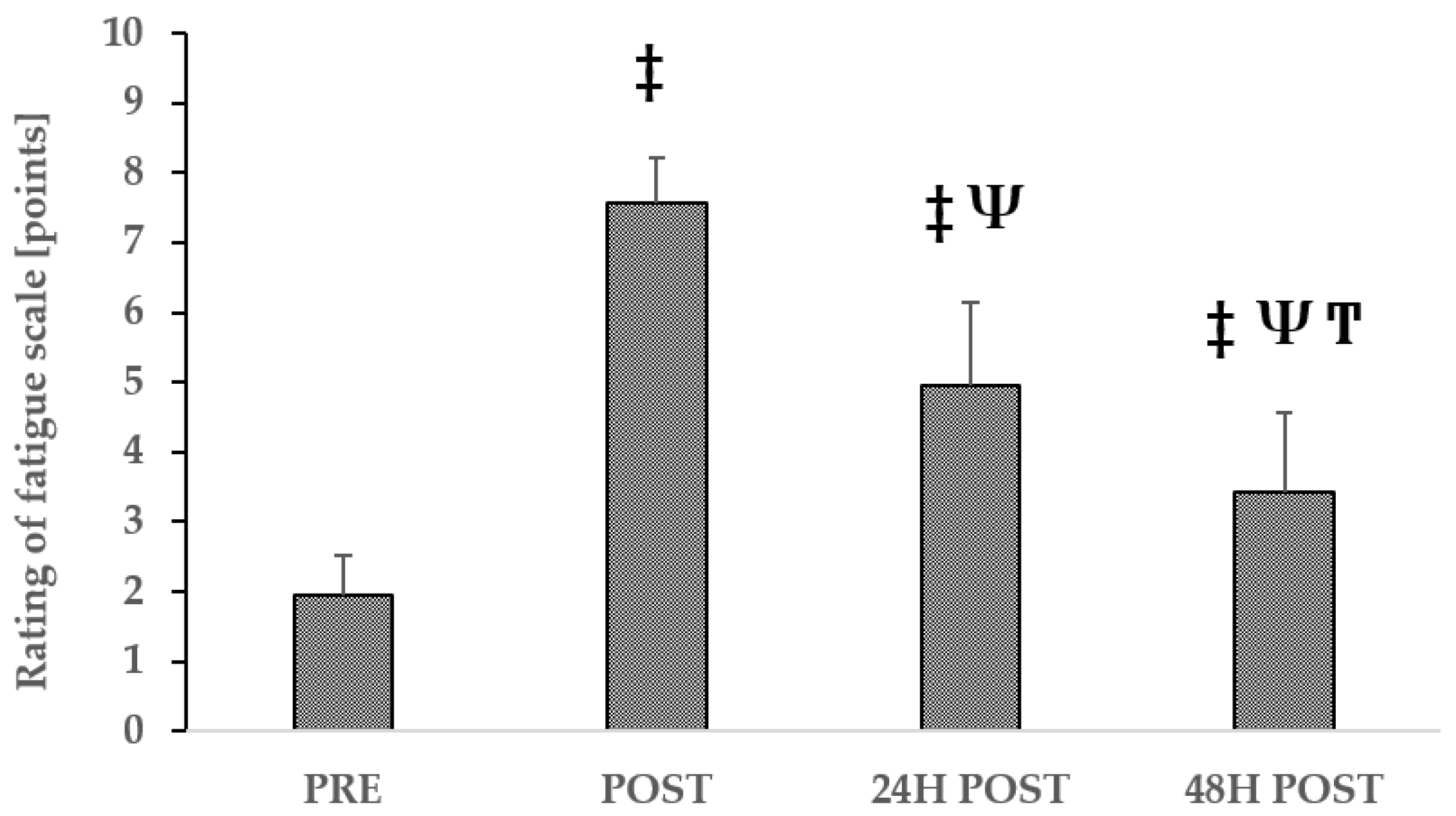
Appendix A.5
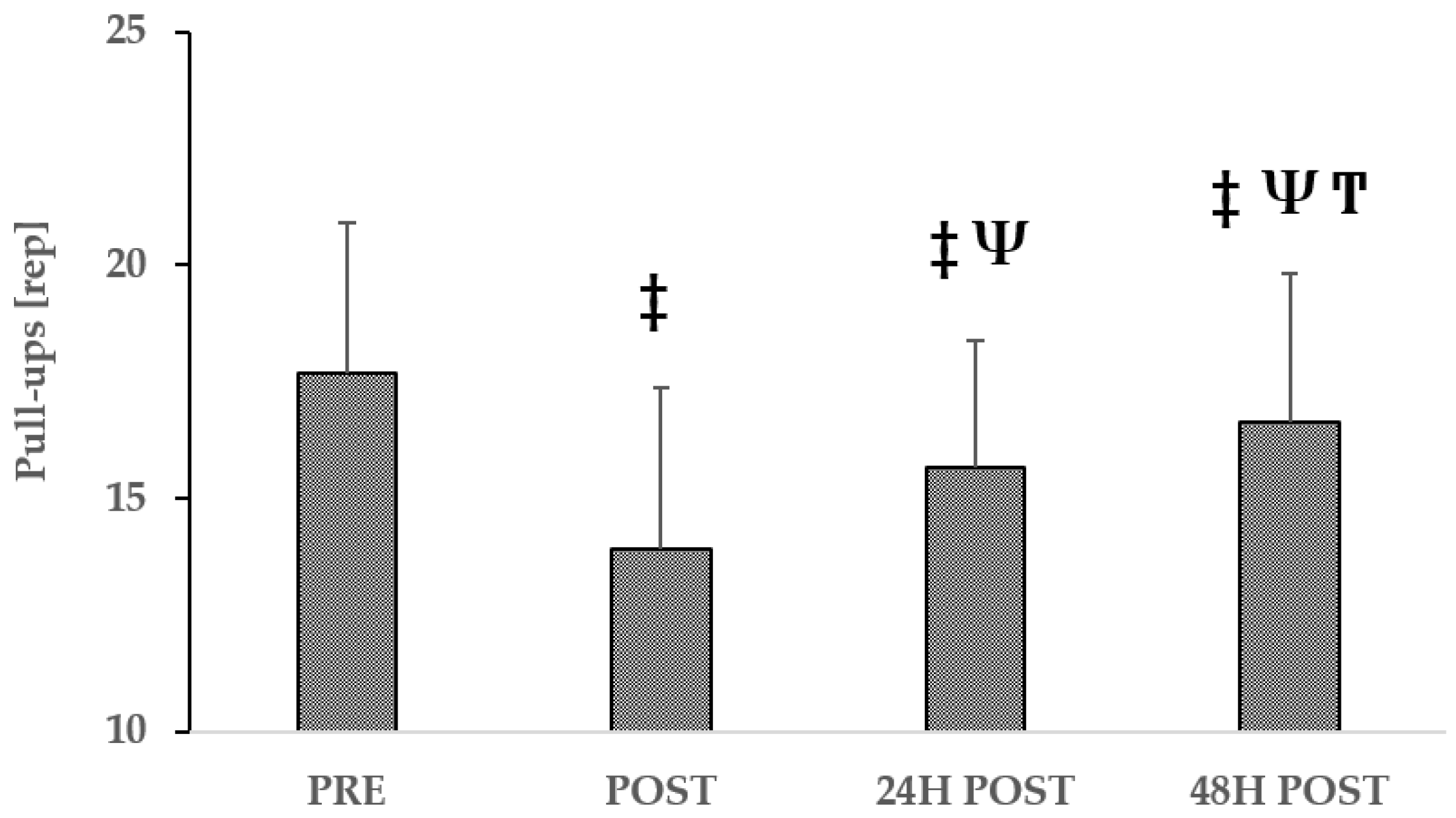
Appendix A.6
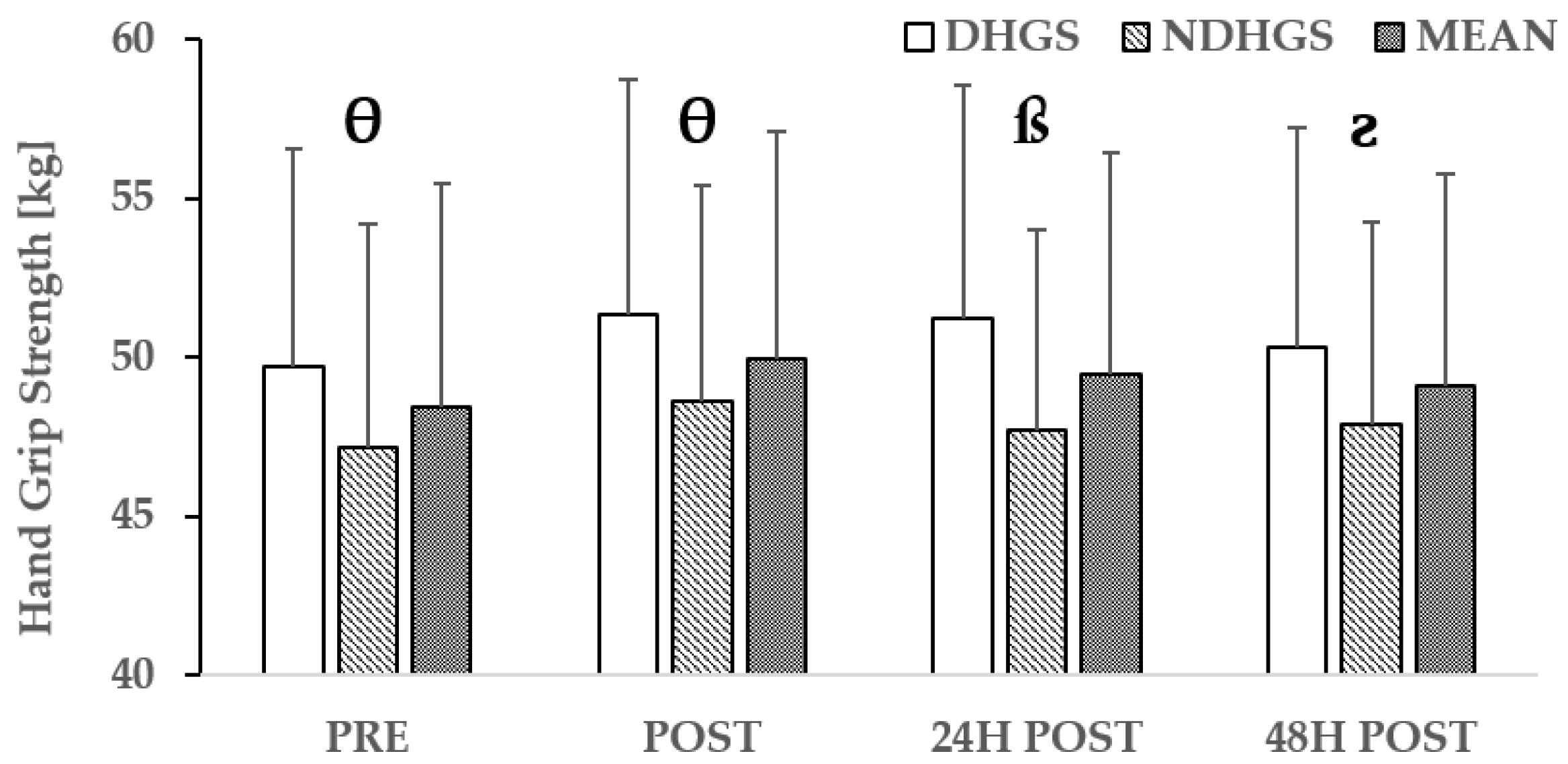
Appendix A.7
| T1 (0–10 km) | T2 (10–15 km) | T3 (15–20 km) | T4 (20–25 km) | T5 (25–30 km) | ES 1 | ES 2 | ES 3 | ES 4 | |
|---|---|---|---|---|---|---|---|---|---|
| Fatigue | 30.00 ± 22.16 | 32.61 ± 22.00 | 37.83 ± 25.93 § | 41.74 ± 26.74 †¥ | 54.78 ± 29.52 ‡ΨͲΣ | −0.15 | −0.38 | −0.60 | −0.99 |
| Muscle pain | 37.83 ± 24.30 | 39.13 ± 24.66 | 53.48 ± 23.86 †Ψ | 61.30 ± 24.74 ‡ΨꝽ | 70.43 ± 19.42 ‡ΨͲꝊ | −0.06 | −0.66 | −1.31 | −1.48 |
| Joint pain | 33.91 ± 26.07 | 32.61 ± 22.00 | 40.43 ± 26.54 § | 49.57 ± 29.46 ‡ΨꝽ | 60.00 ± 28.60 ‡ΨͲΣ | 0.06 | −0.32 | −1.02 | −1.39 |
| Shortness of breath | 24.78 ± 14.73 | 24.78 ± 14.73 | 24.78 ± 14.73 | 30.00 ± 20.23 *§Ᵹ | 35.22 ± 23.33 †¥ŦꝊ | ND | ND | −0.45 | −0.71 |
| Excessive sweating | 27.39 ± 17.89 | 31.30 ± 19.14 | 31.30 ± 16.87 | 41.74 ± 25.16 †¥Ŧ | 48.26 ± 25.16 ‡ΨͲ | −0.38 | −0.29 | −0.72 | −0.91 |
| Muscle tremor | 24.78 ± 14.73 | 23.48 ± 12.65 | 24.78 ± 14.73 | 26.09 ± 16.44 | 30.00 ± 18.09 §Ᵹ | 0.21 | 0.00 | −0.12 | −0.35 |
| Palpitations | 24.78 ± 14.73 | 26.09 ± 16.44 | 26.09 ± 16.44 | 26.09 ± 16.44 | 30.00 ± 20.23 | −0.12 | −0.12 | −0.12 | −0.30 |
References
- Knapik, J.J.; Reynolds, K.L.; Harman, E. Soldier load carriage: Historical, physiological, biomechanical, and medical aspects. Mil. Med. 2004, 169, 45–56. [Google Scholar] [CrossRef] [PubMed]
- Harper, W.; Knapik, J.; de Pontbriand, R. An Investigation of Female Load Carriage Capability; Technical Report: ARL-TR-1176; US Army Research Laboratory: Adelphi, MD, USA, 1997. [Google Scholar]
- Knapik, J.J.; Johnson, R.F.; Ang, P.; Meiselman, H.L.; Bensel, C.K.; Johnson, W.; Flynn, B.; Hanlon, W.; Kirk, J.; Harman, E.; et al. Road March Performance of Special Operations Soldiers Carrying Various Loads and Load Distributions; Technical Report: T14-93; US Army Research Institute of Environmental Medicine: Natick, MA, USA, 1993. [Google Scholar]
- Dean, C.E. The Modern Warrior’s Combat Load—Dismounted Operations in Afghanistan: 356: 1:35 PM–1:50 PM. ACSM J. 2008, 40, 60. [Google Scholar] [CrossRef]
- Nindl, B.C.; Alvar, B.A.; Dudley, J.R.; Favre, M.W.; Martin, G.J.; Sharp, M.A.; Warr, B.J.; Stephenson, M.D.; Kraemer, W.J. Executive Summary From the National Strength and Conditioning Association’s Second Blue Ribbon Panel on Military Physical Readiness: Military Physical Performance Testing. J. Strength Cond. Res. 2015, 29, S216–S220. [Google Scholar] [CrossRef] [PubMed]
- Boffey, D.; Harat, I.; Gepner, Y.; Frosti, C.L.; Funk, S.; Hoffman, J.R. The Physiology and Biomechanics of Load Carriage Performance. Mil. Med. 2019, 184, e83–e90. [Google Scholar] [CrossRef]
- Faghy, M.A.; Shei, R.J.; Armstrong, N.C.D.; White, M.; Lomax, M. Physiological impact of load carriage exercise: Current understanding and future research directions. Physiol. Rep. 2022, 10, e15502. [Google Scholar] [CrossRef]
- Borghols, E.A.; Dresen, M.H.; Hollander, A.P. Influence of heavy weight carrying on the cardiorespiratory system during exercise. Eur. J. Appl. Physiol. Occup. Physiol. 1978, 38, 161–169. [Google Scholar] [CrossRef]
- Hadid, A.; Belzer, N.; Shabshin, N.; Epstein, Y.; Gefen, A. Deformations in the Shoulder Tissues During Load Carriage: A Computational Model. J. Strength Cond. Res. 2015, 29, S144–S148. [Google Scholar] [CrossRef]
- Coast, J.R.; Clifford, P.S.; Henrich, T.W.; Stray-Gundersen, J.; Johnson, R.L. Maximal inspiratory pressure following maximal exercise in trained and untrained subjects. Med. Sci. Sports Exerc. 1990, 22, 811–815. [Google Scholar] [CrossRef]
- Liew, B.; Morris, S.; Netto, K. The Effect of Backpack Carriage on the Biomechanics of Walking: A Systematic Review and Preliminary Meta-Analysis. J. Appl. Biomech. 2016, 32, 614–629. [Google Scholar] [CrossRef]
- Nindl, B.C.; Williams, T.J.; Deuster, P.A.; Butler, N.L.; Jones, B.H. Strategies for optimizing military physical readiness and preventing musculoskeletal injuries in the 21st century. US Army Med. Dep. J. 2013, 5–23. [Google Scholar] [PubMed]
- Jones, B.H.; Canham-Chervak, M.; Canada, S.; Mitchener, T.A.; Moore, S. Medical surveillance of injuries in the u.s. Military descriptive epidemiology and recommendations for improvement. Am. J. Prev. Med. 2010, 38, S42–S60. [Google Scholar] [CrossRef] [PubMed]
- Bahr, R. No injuries, but plenty of pain? On the methodology for recording overuse symptoms in sports. Br. J. Sports Med. 2009, 43, 966–972. [Google Scholar] [CrossRef]
- Grier, T.; Canham-Chervak, M.; McNulty, V.; Jones, B.H. Extreme conditioning programs and injury risk in a US Army Brigade Combat Team. US Army Med. Dep. J. 2013, 36–47. [Google Scholar] [PubMed]
- Bell, N.S.; Mangione, T.W.; Hemenway, D.; Amoroso, P.J.; Jones, B.H. High injury rates among female army trainees: A function of gender? Am. J. Prev. Med. 2000, 18, 141–146. [Google Scholar] [CrossRef]
- Knapik, J.; Bahrke, M.; Staab, J.; Reynolds, K.; Vogel, J. Frequency of Loaded Road March Training and Performance on a Loaded Road March; Technical Report: T13-90; US Army Research Institute of Environmental Medicine: Natick, MA, USA, 1990. [Google Scholar]
- Grenier, J.G.; Millet, G.Y.; Peyrot, N.; Samozino, P.; Oullion, R.; Messonnier, L.; Morin, J.-B. Effects of Extreme-Duration Heavy Load Carriage on Neuromuscular Function and Locomotion: A Military-Based Study. PLoS ONE 2012, 7, e43586. [Google Scholar] [CrossRef] [PubMed]
- Polcyn, A.F.; Bessel, C.K.; Harman, E.A.; Obusek, J.P. The Effects of Load Weight: A Summary Analysis of Maximal Performance, Physiological, and Biomechanical Results from Four Studies of Load-Carriage Systems; Technical Report: ADP010993; US Army Research Institute of Environmental Medicine: Natick, MA, USA, 2001. [Google Scholar]
- Harman, E.A.; Gutekunst, D.J.; Frykman, P.N.; Nindl, B.C.; Alemany, J.A.; Mello, R.P.; Sharp, M.A. Effects of two different eight-week training programs on military physical performance. J. Strength Cond. Res. 2008, 22, 524–534. [Google Scholar] [CrossRef]
- Hendrickson, N.R.; Sharp, M.A.; Alemany, J.A.; Walker, L.A.; Harman, E.A.; Spiering, B.A.; Hatfield, D.L.; Yamamoto, L.M.; Maresh, C.M.; Kraemer, W.J.; et al. Combined resistance and endurance training improves physical capacity and performance on tactical occupational tasks. Eur. J. Appl. Physiol. 2010, 109, 1197–1208. [Google Scholar] [CrossRef] [PubMed]
- Kraemer, W.J.; Vescovi, J.D.; Volek, J.S.; Nindl, B.C.; Newton, R.U.; Patton, J.F.; Dziados, J.E.; French, D.N.; Häkkinen, K. Effects of concurrent resistance and aerobic training on load-bearing performance and the Army physical fitness test. Mil. Med. 2004, 169, 994–999. [Google Scholar] [CrossRef]
- World Medical Association. World Medical Association Declaration of Helsinki: Ethical principles for medical research involving human subjects. JAMA 2013, 310, 2191–2194. [Google Scholar] [CrossRef]
- Grgic, J.; Scapec, B.; Mikulic, P.; Pedisic, Z. Test-retest reliability of isometric mid-thigh pull maximum strength assessment: A systematic review. Biol. Sport 2022, 39, 407–414. [Google Scholar] [CrossRef]
- Markovic, G.; Dizdar, D.; Jukic, I.; Cardinale, M. Reliability and factorial validity of squat and countermovement jump tests. J. Strength Cond. Res. 2004, 18, 551–555. [Google Scholar] [PubMed]
- Hébert-Losier, K.; Beaven, C.M. The MARS for squat, countermovement, and standing long jump performance analyses: Are measures reproducible? J. Strength Cond. Res. 2014, 28, 1849–1857. [Google Scholar] [CrossRef] [PubMed]
- Micklewright, D.; St Clair Gibson, A.; Gladwell, V.; Al Salman, A. Development and Validity of the Rating-of-Fatigue Scale. Sports Med. 2017, 47, 2375–2393. [Google Scholar] [CrossRef] [PubMed]
- Hauschild, V.D.; DeGroot, D.W.; Hall, S.M.; Grier, T.L.; Deaver, K.D.; Hauret, K.G.; Jones, B.H. Fitness tests and occupational tasks of military interest: A systematic review of correlations. Occup. Environ. Med. 2017, 74, 144–153. [Google Scholar] [CrossRef]
- Sanchez-Moreno, M.; Pareja-Blanco, F.; Diaz-Cueli, D.; González-Badillo, J.J. Determinant factors of pull-up performance in trained athletes. J. Sports Med. Phys. Fit. 2016, 56, 825–833. [Google Scholar]
- Vanderburgh, P.M.; Edmonds, T. The Effect of Experimental Alterations in Excess Mass on Pull-up Performance in Fit Young Men. J. Strength Cond. Res. 1997, 11, 230–233. [Google Scholar]
- Canino, M.C.; Foulis, S.A.; Zambraski, E.J.; Cohen, B.S.; Redmond, J.E.; Hauret, K.G.; Frykman, P.N.; Sharp, M.A. U.S. Army Physical Demands Study: Differences in Physical Fitness and Occupational Task Performance Between Trainees and Active Duty Soldiers. J. Strength Cond. Res. 2019, 33, 1864–1870. [Google Scholar] [CrossRef]
- Batterham, A.M.; Hopkins, W.G. Making meaningful inferences about magnitudes. Int. J. Sports Physiol. Perform. 2006, 1, 50–57. [Google Scholar] [CrossRef]
- Cohen, J. Statistical Power Analysis for the Behavioral Sciences, 2nd ed.; Lawrence Erlbaum: Hillsdale, NJ, USA, 1988; p. 567. [Google Scholar]
- Hopkins, W.G.; Marshall, S.W.; Batterham, A.M.; Hanin, J. Progressive statistics for studies in sports medicine and exercise science. Med. Sci. Sports Exerc. 2009, 41, 3–13. [Google Scholar] [CrossRef]
- Tornero-Aguilera, J.F.; Robles-Pérez, J.J.; Clemente-Suárez, V.J. Effect of Combat Stress in the Psychophysiological Response of Elite and Non-Elite Soldiers. J. Med. Syst. 2017, 41, 100. [Google Scholar] [CrossRef]
- Ojanen, T.; Kyröläinen, H.; Igendia, M.; Häkkinen, K. Effect of Prolonged Military Field Training on Neuromuscular and Hormonal Responses and Shooting Performance in Warfighters. Mil. Med. 2018, 183, e705–e712. [Google Scholar] [CrossRef]
- Clemente-Suárez, V.J.; Robles-Pérez, J.J.; Fernández-Lucas, J. Psycho-physiological response in an automatic parachute jump. J. Sports Sci. 2017, 35, 1872–1878. [Google Scholar] [CrossRef] [PubMed]
- Clemente-Suarez, V.J.; Palomera, P.R.; Robles-Pérez, J.J. Psychophysiological response to acute-high-stress combat situations in professional soldiers. Stress Health 2018, 34, 247–252. [Google Scholar] [CrossRef] [PubMed]
- Barr, A.E.; Barbe, M.F. Pathophysiological Tissue Changes Associated With Repetitive Movement: A Review of the Evidence. Phys. Ther. 2002, 82, 173–187. [Google Scholar] [CrossRef]
- Barbe, M.F.; Gallagher, S.; Massicotte, V.S.; Tytell, M.; Popoff, S.N.; Barr-Gillespie, A.E. The interaction of force and repetition on musculoskeletal and neural tissue responses and sensorimotor behavior in a rat model of work-related musculoskeletal disorders. BMC Musculoskelet. Disord. 2013, 14, 303. [Google Scholar] [CrossRef] [PubMed]
- Barbe, M.F.; Gallagher, S.; Popoff, S.N. Serum Biomarkers as Predictors of Stage of Work-related Musculoskeletal Disorders. J. Am. Acad. Orthop. Surg. 2013, 21, 644. [Google Scholar] [CrossRef]
- Knapik, J.; Staab, J.; Bahrke, M.; Reynolds, K.; Vogel, J.; O’Connor, J. Soldier performance and mood states following a strenuous road march. Mil. Med. 1991, 156, 197–200. [Google Scholar] [CrossRef]
- Nindl, B.C.; Barnes, B.R.; Alemany, J.A.; Frykman, P.N.; Shippee, R.L.; Friedl, K.E. Physiological consequences of U.S. Army Ranger training. Med. Sci. Sports Exerc. 2007, 39, 1380–1387. [Google Scholar] [CrossRef]
- Lepers, R.; Pousson, M.L.; Maffiuletti, N.A.; Martin, A.; Van Hoecke, J. The effects of a prolonged running exercise on strength characteristics. Int. J. Sports Med. 2000, 21, 275–280. [Google Scholar] [CrossRef]
- Mero, A.; Komi, P.V. Force-, EMG-, and elasticity-velocity relationships at submaximal, maximal and supramaximal running speeds in sprinters. Eur. J. Appl. Physiol. Occup. Physiol. 1986, 55, 553–561. [Google Scholar] [CrossRef]
- Váczi, M.; Rácz, L.; Hortobágyi, T.; Tihanyi, J. Dynamic contractility and efficiency impairments in stretch-shortening cycle are stretch-load-dependent after training-induced muscle damage. J. Strength Cond. Res. 2013, 27, 2171–2179. [Google Scholar] [CrossRef]
- Komi, P.V. Stretch-shortening cycle: A powerful model to study normal and fatigued muscle. J. Biomech. 2000, 33, 1197–1206. [Google Scholar] [CrossRef] [PubMed]
- Dousset, E.; Avela, J.; Ishikawa, M.; Kallio, J.; Kuitunen, S.; Kyröláinen, H.; Linnamo, V.; Komi, P.V. Bimodal recovery pattern in human skeletal muscle induced by exhaustive stretch-shortening cycle exercise. Med. Sci. Sports Exerc. 2007, 39, 453–460. [Google Scholar] [CrossRef]
- Rousanoglou, E.N.; Noutsos, K.; Pappas, A.; Bogdanis, G.; Vagenas, G.; Bayios, I.A.; Boudolos, K.D. Alterations of Vertical Jump Mechanics after a Half-Marathon Mountain Running Race. J. Sports Sci. Med. 2016, 15, 277–286. [Google Scholar] [PubMed]
- Hein, J.L.; Sesno, N.N.; Armenta, R.F.; Nessler, J.A.; Asakawa, D.S. Upper limb manual dexterity, strength and blood flow after walking with backpack load. Appl. Ergon. 2021, 97, 103505. [Google Scholar] [CrossRef] [PubMed]
- Knapik, J.; Daniels, W.; Murphy, M.; Fitzgerald, P.; Drews, F.; Vogel, J. Physiological factors in infantry operations. Eur. J. Appl. Physiol. Occup. Physiol. 1990, 60, 233–238. [Google Scholar] [CrossRef]
- Patton, J.F.; Vogel, J.A.; Damokosh, A.I.; Mello, R.P. Effects of continuous military operations on physical fitness capacity and physical performance. Work Stress 1989, 3, 69–77. [Google Scholar] [CrossRef]
- Bessen, R.J.; Belcher, V.W.; Franklin, R.J. Rucksack paralysis with and without rucksack frames. Mil. Med. 1987, 152, 372–375. [Google Scholar] [CrossRef]
- Wilson, W.J. Brachial plexus palsy in basic trainees. Mil. Med. 1987, 152, 519–522. [Google Scholar] [CrossRef]
- Parkinson, A.O.; Apps, C.L.; Morris, J.G.; Barnett, C.T.; Lewis, M.G.C. The Calculation, Thresholds and Reporting of Inter-Limb Strength Asymmetry: A Systematic Review. J. Sports Sci. Med. 2021, 20, 594–617. [Google Scholar] [CrossRef] [PubMed]
- MacDonald, G.Z.; Mazara, N.; Herzog, W.; Power, G.A. Mitigating the bilateral deficit: Reducing neural deficits through residual force enhancement and activation reduction. Eur. J. Appl. Physiol. 2018, 118, 1911–1919. [Google Scholar] [CrossRef] [PubMed]
- Grandou, C.; Wallace, L.; Fullagar, H.H.K.; Duffield, R.; Burley, S. The Effects of Sleep Loss on Military Physical Performance. Sports Med. 2019, 49, 1159–1172. [Google Scholar] [CrossRef] [PubMed]
- Orr, R.; Pope, R.; Lopes, T.J.A.; Leyk, D.; Blacker, S.; Bustillo-Aguirre, B.S.; Knapik, J.J. Soldier Load Carriage, Injuries, Rehabilitation and Physical Conditioning: An International Approach. Int. J. Environ. Res. Public Health 2021, 18, 4010. [Google Scholar] [CrossRef] [PubMed]
- Knapik, J.J.; Harman, E.A.; Steelman, R.A.; Graham, B.S. A systematic review of the effects of physical training on load carriage performance. J. Strength Cond. Res. 2012, 26, 585–597. [Google Scholar] [CrossRef]
Disclaimer/Publisher’s Note: The statements, opinions and data contained in all publications are solely those of the individual author(s) and contributor(s) and not of MDPI and/or the editor(s). MDPI and/or the editor(s) disclaim responsibility for any injury to people or property resulting from any ideas, methods, instructions or products referred to in the content. |
© 2025 by the authors. Licensee MDPI, Basel, Switzerland. This article is an open access article distributed under the terms and conditions of the Creative Commons Attribution (CC BY) license (https://creativecommons.org/licenses/by/4.0/).
Share and Cite
Cáceres-Diego, B.; Marín-Pagán, C.; Martínez de Baños, P.; Alcaraz, P.E. Effects of a 30 K Military Loaded Carriage on the Neuromuscular System in Spanish Army Marines. Sports 2025, 13, 76. https://doi.org/10.3390/sports13030076
Cáceres-Diego B, Marín-Pagán C, Martínez de Baños P, Alcaraz PE. Effects of a 30 K Military Loaded Carriage on the Neuromuscular System in Spanish Army Marines. Sports. 2025; 13(3):76. https://doi.org/10.3390/sports13030076
Chicago/Turabian StyleCáceres-Diego, Beltrán, Cristian Marín-Pagán, Pablo Martínez de Baños, and Pedro E. Alcaraz. 2025. "Effects of a 30 K Military Loaded Carriage on the Neuromuscular System in Spanish Army Marines" Sports 13, no. 3: 76. https://doi.org/10.3390/sports13030076
APA StyleCáceres-Diego, B., Marín-Pagán, C., Martínez de Baños, P., & Alcaraz, P. E. (2025). Effects of a 30 K Military Loaded Carriage on the Neuromuscular System in Spanish Army Marines. Sports, 13(3), 76. https://doi.org/10.3390/sports13030076







